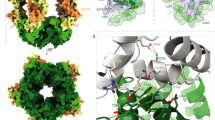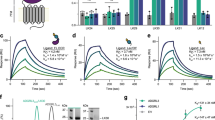Abstract
The neural cell adhesion molecule (NCAM) plays a key role in neural development, regeneration, and learning. In this study, we identified a synthetic peptide-ligand of the NCAM Ig1 module by combinatorial chemistry and showed it could modulate NCAM-mediated cell adhesion and signal transduction with high potency. In cultures of dissociated neurons, this peptide, termed C3, stimulated neurite outgrowth by activating a signaling pathway identical to that activated by homophilic NCAM binding. A similar effect was shown for the NCAM Ig2 module, the endogenous ligand of NCAM Ig1. By nuclear magnetic resonance spectroscopy, the C3 binding site in the NCAM Ig1 module was mapped and shown to be different from the binding site of the NCAM Ig2 module. The C3 peptide may prove useful as a lead in development of therapies for neurodegenerative disorders, and the C3 binding site of NCAM Ig1 may represent a target for discovery of nonpeptide drugs.
This is a preview of subscription content, access via your institution
Access options
Subscribe to this journal
Receive 12 print issues and online access
$209.00 per year
only $17.42 per issue
Buy this article
- Purchase on Springer Link
- Instant access to full article PDF
Prices may be subject to local taxes which are calculated during checkout





Similar content being viewed by others
References
Gegelashvili, G. & Bock, E. Cell recognition molecules of the immunoglobulin superfamily in the nervous system. Treatise Biomembranes 3, 33–75 (1996).
Rønn, L.C.B., Hartz, B.P. & Bock, E. The neural cell adhesion molecule (NCAM) in development and plasticity of the nervous system Exp.Gerontol. 33, 853–864 (1999).
Fields, R.D. & Itoh, K. Neural cell adhesion molecule in activity-dependent development and synaptic plasticity. Trends Neurosci. 19, 473–480 (1996).
Cremer, H. et al. Inactivation of the N-CAM gene in mice results in size reduction of the olfactory bulb and deficits in spatial learning . Nature 367, 455–459 (1994).
Tomasiewicz, H. et al. Genetic deletion of a neural cell adhesion molecule variant (N-CAM-180) produces distinct defects in the central nervous system. Neuron 11, 1163–1174 (1993).
Covault, J. & Sanes, J.R. Neural cell adhesion molecule (N-CAM) accumulates in denervated and paralyzed skeletal muscles. Proc. Natl. Acad. Sci. USA 82, 4544–4548 (1985).
Olsen, M., Zuber, C., Roth, J., Linnemann, D. & Bock, E. The ability to re-express polysialylated NCAM in soleus muscle after denervation is reduced in aged rats compared to young adult rats. Int. J. Dev. Neurosci. 13, 97–104 (1995).
Doyle, E., Nolan, P.M., Bell, R. & Regan, C.M. Hippocampal NCAM180 transiently increases sialylation during the acquisition and consolidation of a passive avoidance response in the adult rat. J. Neurosci. Res. 31, 513–523 (1992).
Lüthi, A., Laurent, J.P., Figurov, A., Muller, D. & Schachner, M. Hippocampal long-term potentiation and neural cell adhesion molecules L1 and NCAM. Nature 372, 777–779 (1994).
Rønn, L.C.B., Bock, E., Linnemann, D. & Jahnsen, H. NCAM-antibodies modulate induction of long-term potentiation in rat hippocampal CA1. Brain Res. 677, 145–151 (1995).
Scholey, A.B., Rose, S.P.R., Zamani, M.R., Bock, E. & Schachner, M. A role for the neural cell adhesion molecule (NCAM) in a late, consolidating phase of glycoprotein synthesis 6 hours following passive avoidance training of the young chick. Neuroscience 55, 499–509 (1993).
Thiery, J.P., Brackenbury, R., Rutishauser, U. & Edelman, G.M. Adhesion among neural cells of the chick embryo. II. Purification and characterization of a cell adhesion molecule from neural retina. J. Biol. Chem. 252, 6841–6845 (1977).
Moran, N. & Bock, E. Characterization of the kinetics of neural cell adhesion molecule homophilic binding. FEBS Lett. 242, 121–124 (1988).
Probstmeier, R., Kuhn, K. & Schachner, M. Binding properties of the neural cell adhesion molecule to different components of the extracellular matrix. J. Neurochem. 53, 1794–1801 (1989).
Kadmon, G., Kowitz, A., Altevogt, P. & Schachner, M. The neural cell adhesion molecule N-CAM enhances L1-dependent cell-cell interactions. J. Cell Biol. 110, 193–208 (1990).
Doherty, P. & Walsh, F.S. CAM-FGF receptor interactions: a model for axonal growth. Mol. Cell. Neurosci. 8, 99–111 (1996).
Schuch, U., Lohse, M.J. & Schachner, M. Neural cell adhesion molecules influence second messenger systems. Neuron 3, 13–20 (1989).
Doherty, P., Ashton, S.V., Moore, S.E. & Walsh, F.S. Morphoregulatory activities of NCAM and N-cadherin can be accounted for by G protein-dependent activation of L- and N-type neuronal calcium-channels. Cell 67, 21–33 (1991).
Beggs, H.E., Baragona, S.C., Hemperly, J.J. & Maness, P.F. NCAM140 interacts with the focal adhesion kinase p125fak and the SRC-related tyrosine kinase p59fyn. J. Biol. Chem. 272, 8310–8319 (1997).
Sporns, O., Edelman, G.M. & Crossin, K.L. The neural cell adhesion molecule (N-CAM) inhibits proliferation in primary cultures of rat astrocytes. Proc. Natl. Acad. Sci. USA 92, 542–546 (1995).
Edvardsen, K. et al. Transfection of glioma cells with the neural-cell adhesion molecule NCAM: effect on glioma-cell invasion and growth in vivo. Int. J. Cancer 58, 116–122 (1994).
Krushel, L.A., Tai, M.H., Cunningham, B.A., Edelman, G.M. & Crossin, K.L. Neural cell adhesion molecule (N-CAM) domains and intracellular signaling pathways involved in the inhibition of astrocyte proliferation. Proc. Natl. Acad. Sci. USA 95, 2592–2596 (1998).
Rao, Y., Zhao, X. & Siu, C.H. Mechanism of homophilic binding mediated by the neural cell adhesion molecule NCAM. Evidence for isologous interaction. J. Biol. Chem. 269, 27540–27548 (1994).
Ranheim, T.S., Edelman, G.M. & Cunningham, B.A. Homophilic adhesion mediated by the neural cell adhesion molecule involves multiple immunoglobulin domains. Proc. Natl. Acad. Sci. USA 93, 4071–4075 (1996).
Thomsen, N.K. et al. The three-dimensional structure of the first domain of neural cell adhesion molecule. Nat. Struct. Biol. 3, 581–585. (1996).
Kiselyov, V.V. et al. The first immunoglobulin-like neural cell adhesion molecule (NCAM) domain is involved in double-reciprocal interaction with the second immunoglobulin-like NCAM domain and in heparin binding. J. Biol. Chem. 272, 10125–10134 (1997).
Jensen, P.H. et al. Structure and interactions of NCAM modules 1 and 2—basic elements in neural cell adhesion. Nat. Struct. Biol. 6, 486–493 (1999).
Cwirla, S.E. et al. Peptide agonist of the thrombopoietin receptor as potent as the natural cytokine. Science 276, 1696–1699 (1997).
Wrighton, N.C. et al. Small peptides as potent mimetics of the protein hormone erythropoietin. Science 273, 458–464 (1996).
Maar, T.E. et al. Characterization of microwell cultures of dissociated brain tissue for studies of cell-cell interactions. J. Neurosci. Res. 47, 163–172 (1997).
Williams, E.J., Furness, J., Walsh, F.S. & Doherty, P. Activation of the FGF receptor underlies neurite outgrowth stimulated by L1, NCAM, and N-cadherin. Neuron 13, 583–594 (1994).
Williams, E.J., Furness, J., Walsh, F.S. & Doherty, P. Characterisation of the second messenger pathway underlying neurite outgrowth stimulated by FGF. Development 120, 1685–1693 (1994).
Williams, E.J., Mittal, B., Walsh, F.S. & Doherty, P. FGF inhibits neurite outgrowth over monolayers of astrocytes and fibroblasts expressing transfected cell adhesion molecules. J. Cell Sci. 108, 3523–3530 (1995).
Williams, E.J., Walsh, F.S. & Doherty, P. Tyrosine kinase inhibitors can differentially inhibit integrin-dependent and CAM-stimulated neurite outgrowth. J. Cell Biol. 124, 1029–1037 (1994).
Furka, A., Sebestyen, F., Asgedom, M. & Dibo, G. General method for rapid synthesis of multicomponent peptide mixtures. Int. J. Pept. Prot. Res. 37, 487–493 (1991).
Østergaard, S., Hansen, P.H., Olsen, M. & Holm, A. Novel avidin and streptavidin binding sequences found in synthetic peptide libraries. FEBS Lett. 362, 306–308 (1995).
Braunsweiler, L. & Ernst, R.R. Coherence transfer by isotropic mixing: Application to proton correlation spectroscopy. J. Magn. Reson. 53, 521–528 (1983).
Piantini, U., Sørensen, O.W. & Ernst, R.R. Multiple quantum filters for elucidating NMR coupling networks. J. Am. Chem. Soc. 104, 6800–6801 (1982).
Kumar, A., Wagner, G., Ernst, R.R. & Wüthrich, K. Buildup rates of the nuclear Overhauser effect measured by two-dimensional proton magnetic resonance spectroscopy: implications for studies of protein conformation. J. Am. Chem. Soc. 103, 3654–3658 (1981).
Bothner-By, A.A., Stephens, R.L., Lee, J., Warren, C.D. & Jeanloz, R.W. Structure determination of a tetrasaccharide: transient nuclear Overhauser effects in the rotating frame. J. Am. Chem. Soc. 106, 811–813 (1984).
Kjær, M., Andersen, M.K. & Poulsen, F.M. Automated and semiautomated analysis of homo- and heteronuclear multidimensional nuclear magnetic resonance spectra of proteins: the program Pronto. Methods Enzymol. 239, 288–307 (1994).
Acknowledgements
The group of the Protein Laboratory was supported by the Danish Biotechnology Programme, The Lundbeck Foundation, the Danish Cancer Society, The Plasmid Foundation, The Danish Growth and Regeneration Programme, and the EU Programme on Biotechnology BIO4-CT96-0450. The group of the Carlsberg Laboratory was supported by the Danish Biotechnology Programme. This is a contribution from the Danish Instrument Center for NMR spectroscopy of Biological Macromolecules. We thank Nils Axelsen, Statens Serum Institut, Copenhagen, Denmark for thoughtful comments during the preparation of the manuscript and Jette Petersen and Charlotte Holm for expert technical assistance.
Author information
Authors and Affiliations
Corresponding author
Rights and permissions
About this article
Cite this article
Rønn, L., Olsen, M., Østergaard, S. et al. Identification of a neuritogenic ligand of the neural cell adhesion molecule using a combinatorial library of synthetic peptides. Nat Biotechnol 17, 1000–1005 (1999). https://doi.org/10.1038/13697
Received:
Accepted:
Issue Date:
DOI: https://doi.org/10.1038/13697
This article is cited by
-
NCAM Mimetic Peptides: Potential Therapeutic Target for Neurological Disorders
Neurochemical Research (2018)
-
The DC-SIGN-CD56 interaction inhibits the anti-dendritic cell cytotoxicity of CD56 expressing cells
Infectious Agents and Cancer (2015)
-
Anti-inflammatory properties of a novel peptide interleukin 1 receptor antagonist
Journal of Neuroinflammation (2014)
-
Special Issue Dedicated to Elisabeth Bock
Neurochemical Research (2013)
-
NCAM Function in the Adult Brain: Lessons from Mimetic Peptides and Therapeutic Potential
Neurochemical Research (2013)



